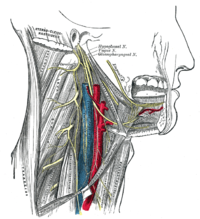
Photo from wikipedia
The most significant complication of parotid gland tumor surgery is facial weakness. This study compares the occurrence of transient facial palsy in patients with parotid gland tumors who underwent surgery… Click to show full abstract
The most significant complication of parotid gland tumor surgery is facial weakness. This study compares the occurrence of transient facial palsy in patients with parotid gland tumors who underwent surgery without monitoring to those who underwent surgery with monitoring. The study's aim was to investigate facial nerve function in patients undergoing parotidectomy as well as the effect of intraoperative facial nerve monitoring and the effect of certain risk factors on the surgery and onset of postoperative facial palsy. This prospective study included 100 patients who underwent parotidectomy. The study cohort was divided into two groups. Group I included 50 patients who underwent surgery without neuromonitoring and group II included 50 patients who underwent surgery with neuromonitoring. The neurological assessment was conducted using the House–Brackmann scale. Preoperatively and one month postoperatively, electroneuronography (ENoG) and blink reflex tests were done. The analyses showed a significant reduction of the compound muscle action potential (CMAP) amplitude of the orbicularis oculi and orbicularis oris muscles and prolonged R1 and R2 blink reflex latencies 1 month after surgery. On neurological and electrophysiological studies, the rate of postoperative transient facial nerve dysfunction was significantly different between the groups. Significantly more patients, operated with use of facial nerve monitoring, presented postoperatively normal nerve function (i.e., House–Brackmann grade I) compared to those who underwent surgery without monitoring (78% and 26%, respectively; p < 0.001). Monitoring had a statistically significant impact on the prevalence of facial nerve conduction disorders in patients who underwent surgery, according to the blink reflex and ENoG studies. The duration of the surgical procedure was not affected by monitoring in any way. The clinical evaluation of facial nerve function (House–Brackmann scale) and some ENoG results 1 month after surgery were found to have a significant correlation. To summarize, using monitoring considerably reduced the negative impact of local factors and the prevalence of transient facial nerve palsy.
Journal Title: BioMed Research International
Year Published: 2022
Link to full text (if available)
Share on Social Media: Sign Up to like & get
recommendations!